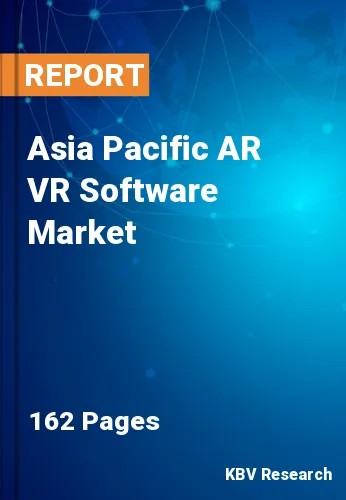Chapter 1. Market Scope & Methodology
1.1 Market Definition
1.2 Objectives
1.3 Market Scope
1.4 Segmentation
1.4.1 Asia Pacific AR VR Software Market, by Vertical
1.4.2 Asia Pacific AR VR Software Market, by Technology Type
1.4.3 Asia Pacific AR VR Software Market, by Software Type
1.4.4 Asia Pacific AR VR Software Market, by Country
1.5 Methodology for the research
Chapter 2. Market at a Glance
2.1 Key Highlights
Chapter 3. Market Overview
3.1 Introduction
3.1.1 Overview
3.1.1.1 Market Composition and Scenario
3.2 Key Factors Impacting the Market
3.2.1 Market Drivers
3.2.2 Market Restraints
Chapter 4. Competition Analysis - Global
4.1 KBV Cardinal Matrix
4.2 Recent Industry Wide Strategic Developments
4.2.1 Partnerships, Collaborations and Agreements
4.2.2 Product Launches and Product Expansions
4.2.3 Acquisition and Mergers
4.2.4 Geographical Expansions
4.3 Market Share Analysis, 2022
4.4 Top Winning Strategies
4.4.1 Key Leading Strategies: Percentage Distribution (2019-2023)
4.4.2 Key Strategic Move: (Partnerships, Collaborations & Agreements: 2019, Oct – 2023, Aug) Leading Players
4.5 Porter’s Five Forces Analysis
Chapter 5. Asia Pacific AR VR Software Market by Vertical
5.1 Asia Pacific Media & Entertainment Market by Country
5.2 Asia Pacific Training & Education Market by Country
5.3 Asia Pacific Travel & Hospitality Market by Country
5.4 Asia Pacific Manufacturing Market by Country
5.5 Asia Pacific Healthcare Market by Country
5.6 Asia Pacific Aerospace & Defense Market by Country
5.7 Asia Pacific Real Estate Market by Country
5.8 Asia Pacific Automotive Market by Country
5.9 Asia Pacific Retail & E-commerce Market by Country
5.10. Asia Pacific Others Market by Country
Chapter 6. Asia Pacific AR VR Software Market by Technology Type
6.1 Asia Pacific AR Software Market by Country
6.2 Asia Pacific VR Software Market by Country
Chapter 7. Asia Pacific AR VR Software Market by Software Type
7.1 Asia Pacific Software Development Kit Market by Country
7.2 Asia Pacific Game Engine Market by Country
7.3 Asia Pacific Modeling & Visualization Software Market by Country
7.4 Asia Pacific Content Management System Market by Country
7.5 Asia Pacific Training & Simulation Software Market by Country
7.6 Asia Pacific Others Market by Country
Chapter 8. Asia Pacific AR VR Software Market by Country
8.1 China AR VR Software Market
8.1.1 China AR VR Software Market by Vertical
8.1.2 China AR VR Software Market by Technology Type
8.1.3 China AR VR Software Market by Software Type
8.2 Japan AR VR Software Market
8.2.1 Japan AR VR Software Market by Vertical
8.2.2 Japan AR VR Software Market by Technology Type
8.2.3 Japan AR VR Software Market by Software Type
8.3 India AR VR Software Market
8.3.1 India AR VR Software Market by Vertical
8.3.2 India AR VR Software Market by Technology Type
8.3.3 India AR VR Software Market by Software Type
8.4 South Korea AR VR Software Market
8.4.1 South Korea AR VR Software Market by Vertical
8.4.2 South Korea AR VR Software Market by Technology Type
8.4.3 South Korea AR VR Software Market by Software Type
8.5 Singapore AR VR Software Market
8.5.1 Singapore AR VR Software Market by Vertical
8.5.2 Singapore AR VR Software Market by Technology Type
8.5.3 Singapore AR VR Software Market by Software Type
8.6 Malaysia AR VR Software Market
8.6.1 Malaysia AR VR Software Market by Vertical
8.6.2 Malaysia AR VR Software Market by Technology Type
8.6.3 Malaysia AR VR Software Market by Software Type
8.7 Rest of Asia Pacific AR VR Software Market
8.7.1 Rest of Asia Pacific AR VR Software Market by Vertical
8.7.2 Rest of Asia Pacific AR VR Software Market by Technology Type
8.7.3 Rest of Asia Pacific AR VR Software Market by Software Type
Chapter 9. Company Profiles
9.1 Microsoft Corporation
9.1.1 Company Overview
9.1.2 Financial Analysis
9.1.3 Segmental and Regional Analysis
9.1.4 Research & Development Expenses
9.1.5 Recent strategies and developments:
9.1.5.1 Partnerships, Collaborations, and Agreements:
9.1.5.2 Acquisition and Mergers:
9.1.6 SWOT Analysis
9.2 Google LLC (Alphabet Inc.)
9.2.1 Company Overview
9.2.2 Financial Analysis
9.2.3 Segmental and Regional Analysis
9.2.4 Research & Development Expense
9.2.5 Recent strategies and developments:
9.2.5.1 Acquisition and Mergers:
9.2.6 SWOT Analysis
9.3 Magic Leap, Inc.
9.3.1 Company Overview
9.3.2 Recent strategies and developments:
9.3.2.1 Partnerships, Collaborations, and Agreements:
9.3.3 SWOT Analysis
9.4 Adobe, Inc.
9.4.1 Company Overview
9.4.2 Financial Analysis
9.4.3 Segmental and Regional Analysis
9.4.4 Research & Development Expense
9.4.5 Recent strategies and developments:
9.4.5.1 Product Launches and Product Expansions:
9.4.5.2 Acquisition and Mergers:
9.4.6 SWOT Analysis
9.5 Autodesk, Inc.
9.5.1 Company Overview
9.5.2 Financial Analysis
9.5.3 Regional Analysis
9.5.4 Research & Development Expenses
9.5.5 SWOT Analysis
9.6 NVIDIA Corporation
9.6.1 Company Overview
9.6.2 Financial Analysis
9.6.3 Segmental and Regional Analysis
9.6.4 Research & Development Expenses
9.6.5 Recent strategies and developments:
9.6.5.1 Partnerships, Collaborations, and Agreements:
9.6.6 SWOT Analysis
9.7 Advanced Micro Devices, Inc.
9.7.1 Company Overview
9.7.2 Financial Analysis
9.7.3 Segmental and Regional Analysis
9.7.4 Research & Development Expenses
9.7.5 Recent strategies and developments:
9.7.5.1 Partnerships, Collaborations, and Agreements:
9.7.6 SWOT Analysis
9.8 Qualcomm, Inc.
9.8.1 Company Overview
9.8.2 Financial Analysis
9.8.3 Segmental and Regional Analysis
9.8.4 Research & Development Expense
9.8.5 Recent strategies and developments:
9.8.5.1 Product Launches and Product Expansions:
9.8.5.2 Geographical Expansions:
9.8.6 SWOT Analysis
9.9 Zoho Corporation Pvt. Ltd.
9.9.1 Company Overview
9.9.2 SWOT Analysis
9.10. Hexagon AB
9.10.1 Company Overview
9.10.2 Financial Analysis
9.10.3 Regional & Segmental Analysis
9.10.4 Research & Development Expenses
9.10.5 Recent strategies and developments:
9.10.5.1 Partnerships, Collaborations, and Agreements:
9.10.6 SWOT Analysis

